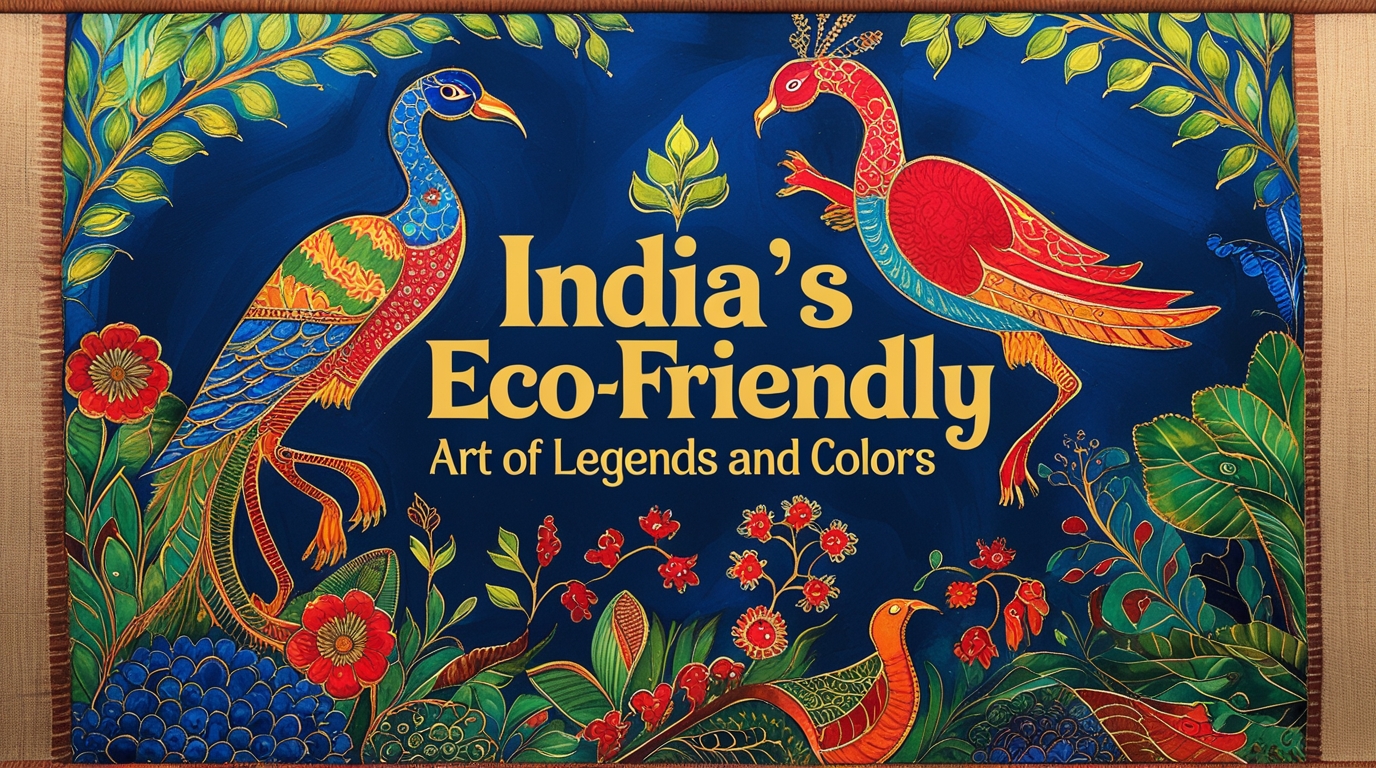kalamkari painting: India’s Eco-Friendly Art of Legends and Colors
A combination of the words “kalam” (meaning “pen”) and “kari” (meaning “artwork”), the term “kalamkari” means “pen craft.” This exquisite work of art is an example of a rare and ancient technique of hand embroidery using a tamarind brush on silk or cotton cloth. Its unique selling point is that it uses no synthetic dyes whatsoever. But making kalamkari painting is a very time-consuming process. A total of twenty-three processes are involved, including bleaching, dying, starching, printing by block or by hand, and many more.
The cities of Machilipatnam and Kalahasti in Andhra Pradesh are the epicentres of the Kalamkari art form. The abundance of pure river water in Srikalahasti made it an ideal location for the practice of this art form. Many women and craftspeople in rural areas used to make a living doing this kind of work. Traditional cotton fabrics decorated with block printing or hand painting are known as kalamkari in India. Its 3,000-year-old roots can be traced to the Indian state of Andhra Pradesh. It became famous in southern India under the Vijayanagara Empire because of the prevalence of its usage in depictions of religious tales and temple art. This practice has been carried down through the years as a family tradition. Even now, Andhra Pradesh is where most of the country’s Kalamkari artists congregate.
Environmental or organic dyes are used to produce elaborate and colorful representations of environmental themes, religious epics, and mythological tales in this old art style. Kalamkari is a traditional handicraft from Andhra Pradesh and a few regions of Tamil Nadu that has become famous all over the world for its exquisite beauty and exquisite workmanship.
A Historical Account of kalamkari painting
Kalamkari was originally practiced by chitrakars, who were artists and musicians from Machilipatnam who would travel from village to village, painting enormous canvases on which they would narrate Hindu legendary tales. Temples frequently house these artworks, which, like Buddhist Thangka paintings, portray mythological events and symbolism.
The craft was originally called “Qualamkars” by the Mughals who patronized the Coromandel and Golconda regions; the term “Kalamkari” developed from this.
The skill evolved in the Pedana area close to Machilipatnam, influenced by Persian art during Islamic rule, and supported by the Mughal and Golconda sultanates.
Techniques to make Kalamkari Paintings
There is a wide variety of 23 processes involved in this intricate art form. To begin, soak the fabric in a mixture of bleach and cow dung before using it. After a few hours in the solution, the fabric will take on a uniformly distributed off-white hue. Step two involves soaking the cloth in a mixture of Myrobalans and buffalo milk. When painting fabric with natural dyes, this keeps the colors from smearing. After that, to remove the smell of buffalo milk, the cloth is washed under a running water stream. The fabric is subjected to a similar washing process twenty times before being left to dry in the sun. Before painting, artists mark the fabric with motifs and designs. The painters of Kalamkari use dyes made from natural ingredients to fill in the designs and patterns. The Qualamkars employ a “tamarind twig” as a writing implement to add precise and intricate details. Lotus and peacock motifs sit with depictions of Hindu deities like Parvathi and Vishnu. Ramayana and Mahabharata, two Hindu mythical epics, are also depicted in this vibrant art genre.
Colors of the kalamkari pattern
Natural, organic colors like mustard, indigo, green, black, and green predominate in this style of kalamkari painting. There are no chemicals or synthetic materials utilized in the extraction of the natural dyes used in painting; they are derived solely from natural resources. Traditional Kalamkar black pigment is made by combining jaggery, iron fillings, and water.
Typically, the drafts of the drawings are outlined in black color. ypically, the drafts of the drawings are outlined in black color. In comparison to the red that is made from algirin or madder tree bark, mustard yellow is made by using boiling pomegranate peels. Indigo is the supply of blue, at the same time as a combination of blue and yellow yields inexperienced. Demons are represented in numerous sunglasses of green and crimson, at the same time as holy deities and heavenly things are depicted in blue. Lotus motifs are the most usual history for this type of artwork.
Also read:
Various Styles of Kalamkari Painting
Based on the areas where the art form originated, kalamkari art can be roughly classified into two styles: Srikalahasti and Machilipatnam. The methods, motifs, and themes that make up each style are distinctive. The pen-and-paper style of Srikalahasti Kalamkari is famous for its depictions of religious and mythological themes, whereas the block-printed style of Machilipatnam Kalamkari is recognized for its floral and geometric patterns.
Both forms, though distinct, are manifestations of the spiritual and cultural importance of Kalamkari that have been preserved over the years by skilled craftspeople:
Srikalahasti Kalamkari
All work in the Srikalahasti style, which is unique to the Tirupati district, is done manually with the kalam (pen). Freehand sketching and elaborate detail define this style, which frequently depicts subjects and characters from mythology.
- Craftspeople use a woolen cloth brush to draw designs on bamboo or date palm poles, which are then colored naturally in either black or red.
- Religious iconography, architectural details of Hindu temples, and Hindu gods are the main subjects of Srikalahasti Kalamkari.
Machilipatnam Kalamkari
Pedana, a town close to Machilipatnam, is the birthplace of Machilipatnam Kalamkari, another name for the same style. The Golconda Sultanate and the Mughals were patrons; therefore, it is heavily influenced by Persian art.
- This style rejects holy Hindu motifs in favor of block-printed designs inspired by Persian art, in contrast to Srikalahasti.
- Birds such as peacocks and parrots, as well as cartwheels, flowers, and leaves are common motifs.
- The style flourished under Mughal domination, particularly following Aurangzeb’s conquest in 1687, to incorporate emperor portraits and settings portraying the opulence of their courts.
How things stand in the present day?
Many have come to appreciate this age-old art form for its grace and beauty. Its brightly colored figures and elaborately hand-crafted patterns are renowned to depict a broad variety of subjects.
The use of harmful chemicals in production and manufacturing is currently opposed by a large number of individuals worldwide. Naturally dyed art styles like Kalamkari should have been booming in this scenario. The laborious process of creating these paintings is causing them to lose their luster. This art style is unfortunately becoming less mysterious as a result of widespread industrialization and modernization. Another factor contributing to the decline of this age-old craft was the advent of modern machine looms and printed textiles.
Kalamkari almost went extinct if it weren’t for the indefatigable efforts of Indian fashion designers to bring it back into the spotlight. The fashion business did a much-needed thing by giving these artists a fair shot at making it big and showing off their skills. Fashion designers that think outside the box have their creations shown to a wider audience. The practice of Kalamkari has been preserved and, with any luck, will be maintained in the future.
Final Words
Unfortunately, kalamkari painting is a traditional Indian art shape that is passed down through generations, typically from fathers or grandfathers to grandchildren. This is the way it has been kept and handed down over the years. However, these days, maximum Kalamkari artists’ kids move into engineering, commerce, or another career that offers a greater solid and appealing profits, way to the abundance of possibilities. Ten of the about sixteen active Kalamkari painters have received national popularity for their work. Pedana Kalamkari’s registration under the Geographical Indications Registry (GIR) in 2013 marked the official recognition of the Kalamkari art form by the Government of India, safeguarding its distinctive legacy.
To similarly spotlight the production and cultural importance of Kalamkari, the Andhra Pradesh government has identified it as the ‘One District One Product’ for Krishna district. Further efforts are needed to preserve this historical artwork shape, because the quantity of artists active in Kalamkari continues to lower despite those measures.



